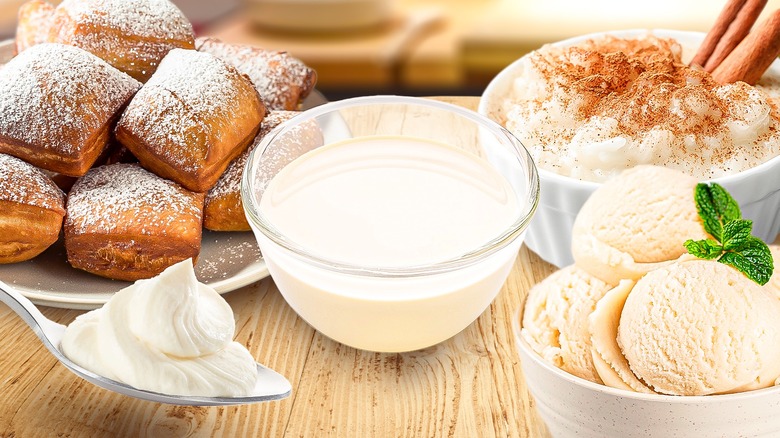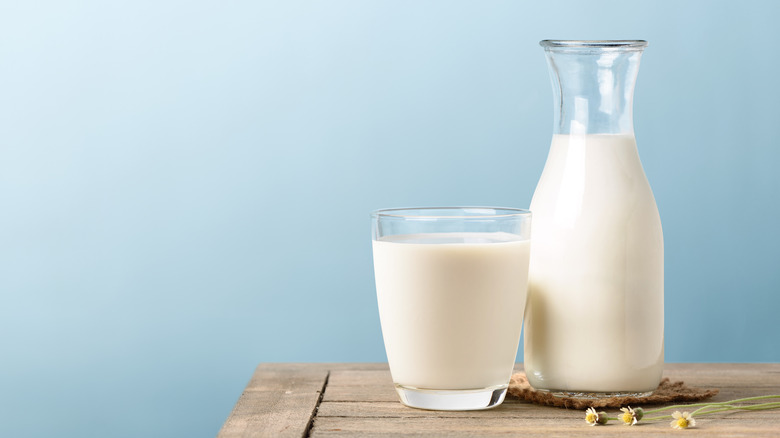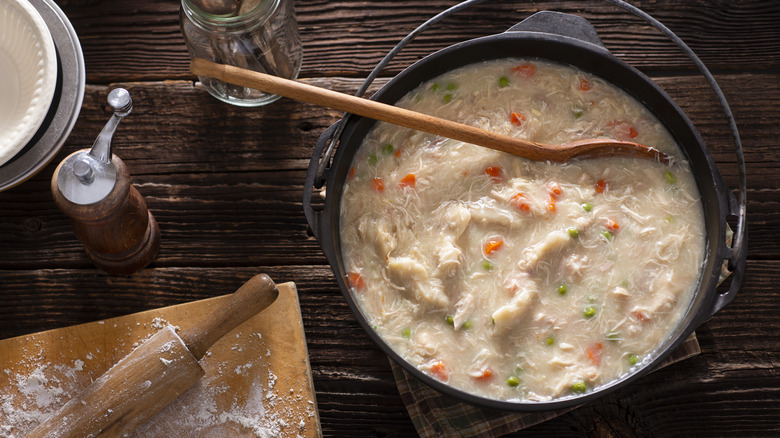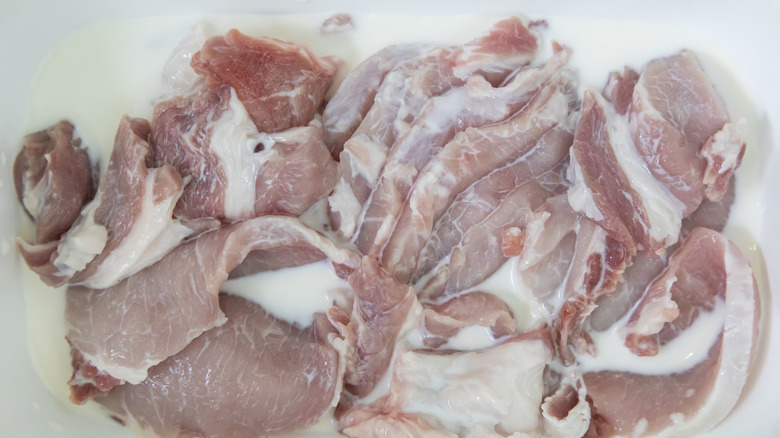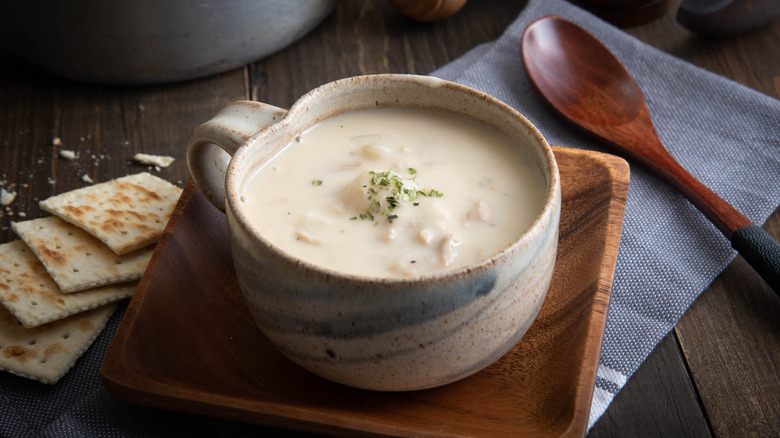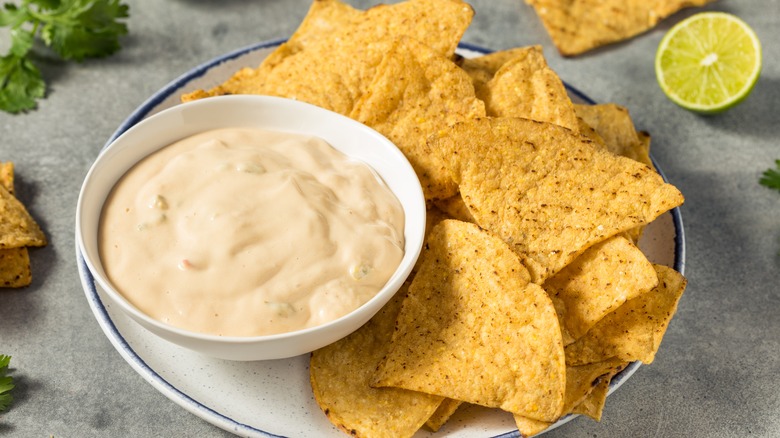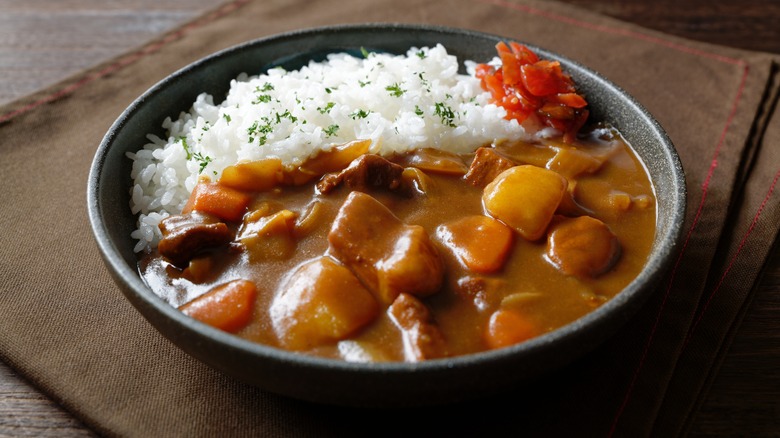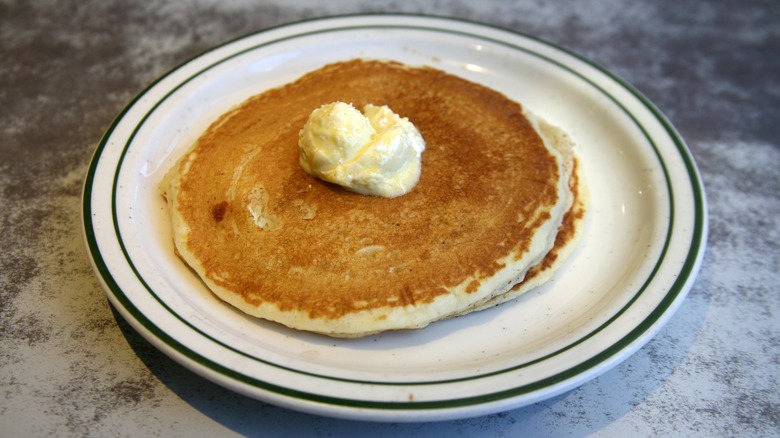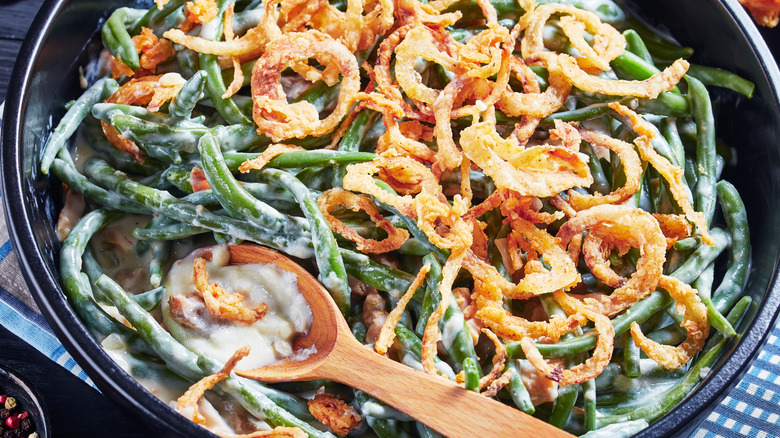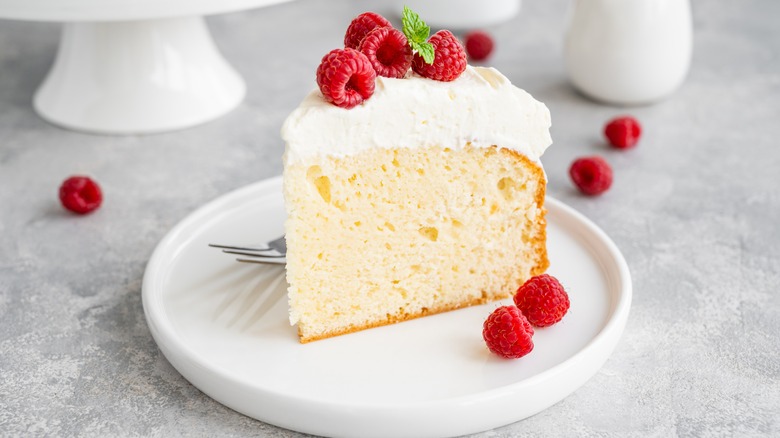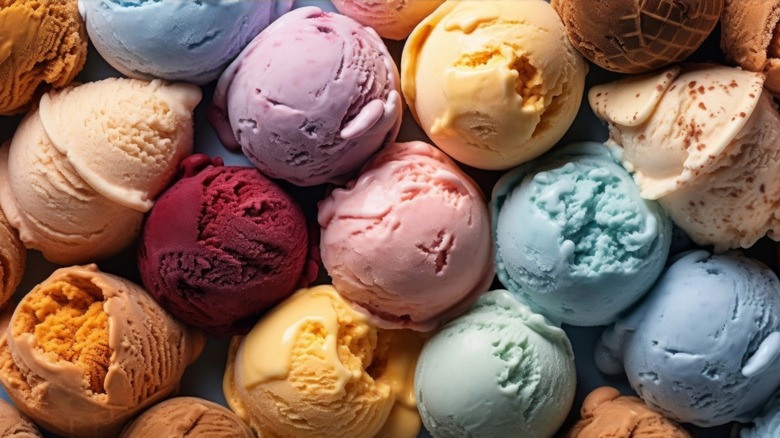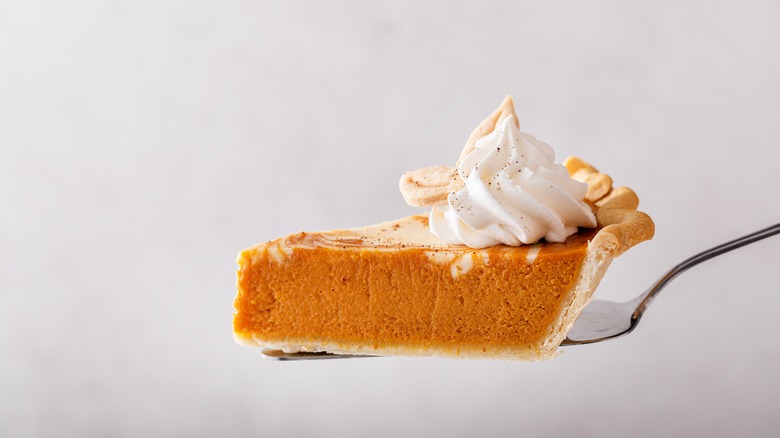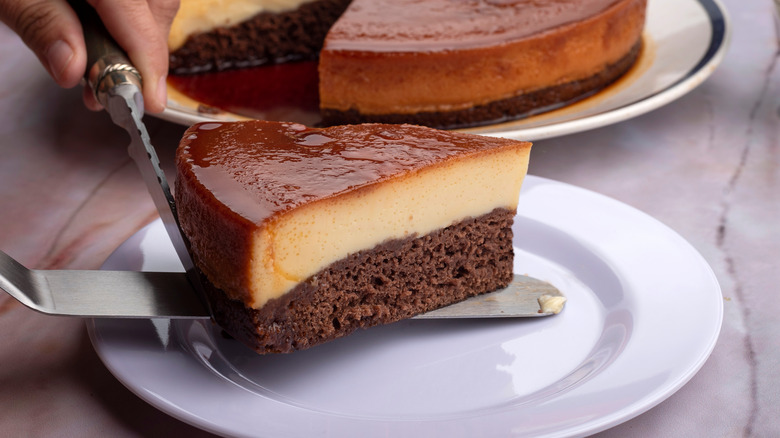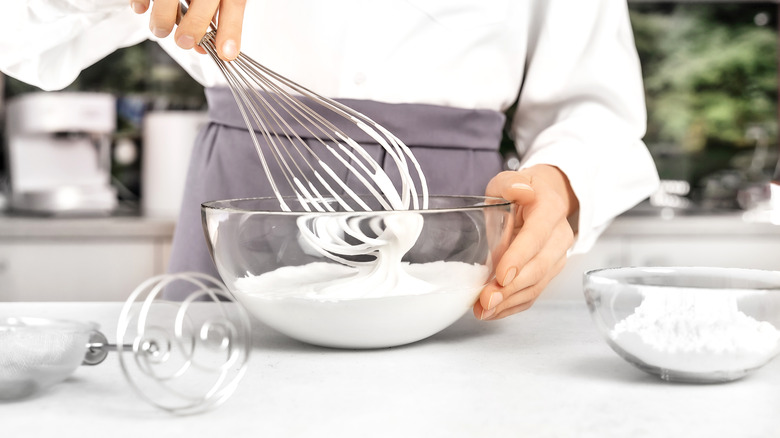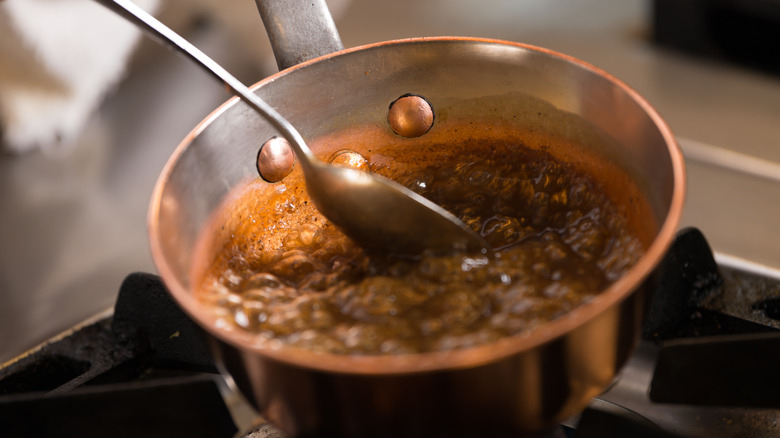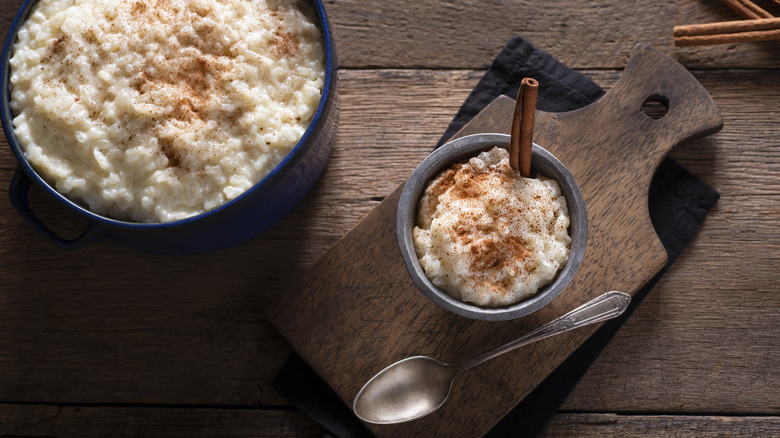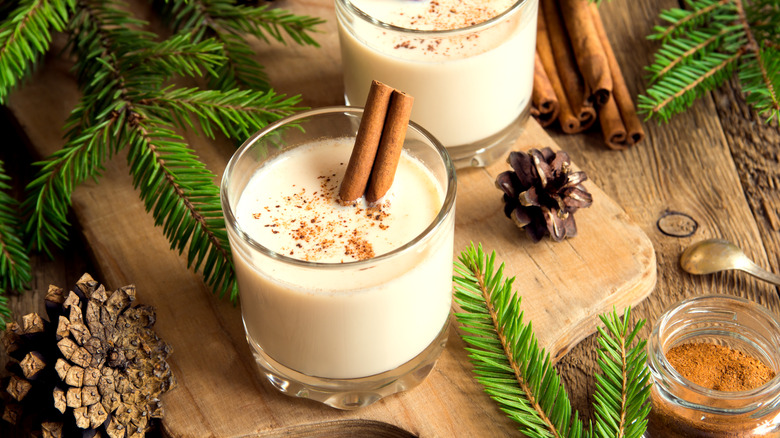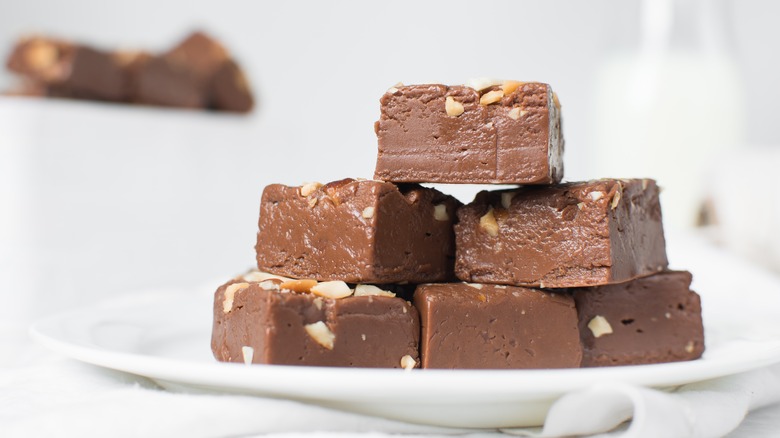19 Best Ways To Use Canned Evaporated Milk
There's a pretty good chance you've got a can of evaporated milk somewhere in your pantry. You might not remember why you bought it in the first place, but it's there — and now you've got to figure out what to do with it.
First things first, though: What is evaporated milk? In the simplest terms, it is milk — usually cow's milk — that has been reduced down to a more concentrated product, with about 60% of the water removed. Unlike sweetened condensed milk, there's no sugar added, so it's thicker than milk from the fridge, but not sticky or syrupy.
Unlike whole milk, heavy cream, or half-and-half, evaporated milk has a more concentrated milk flavor. By volume, evaporated milk is also more dense in nutrients and calories (though Carnation's evaporated milk has 25 to 40 calories per 2-tablespoon serving, while Land O'Lakes heavy cream has 100 calories per 2 tablespoons). Unopened, a can of evaporated milk can hang out on your shelf for well over a year.
Evaporated milk is much more than something to pick up when you're getting ready to bake holiday pies. In fact, it might just be an ingredient you want to have in your cupboard year-round. This creamy, shelf-stable dairy product has a whole lot to offer, whether you're working on a slow-cooker soup or are busting out your ice cream maker. So grab that can and get cooking!
When you run out of regular milk
Evaporated milk was developed as a shelf-stable alternative to fresh milk in the 19th century and first produced commercially in 1885, when refrigeration wasn't reliable. So while it has plenty of other culinary uses today, the original use for evaporated milk was as, well, milk!
Of course, cooking 60% of the water out of milk creates a different product, so it's not a 1:1 replacement for milk when you're cooking — though that rich, creamy taste is great in coffee and oatmeal, and also as an addition to mashed potatoes or milkshakes in place of regular milk.
To use evaporated milk like fresh milk, it needs to be diluted. Carnation recommends diluting their evaporated milk 50-50 with water — 1 part evaporated milk to 1 part water. The resulting milk is not ideal as a swap in baking, but it's delicious in hot chocolate or in a tall glass alongside a slice of cake or a plate of cookies.
Make your next batch of scrambled eggs super fluffy
Eggs are a super adaptable protein that can be served in a variety of ways. But, finding out how to make a good scrambled egg is crucial to your success in the breakfast world. If you're noticing that your eggs are coming out super stodgy, you might not be adding the right ingredients to them. Instead of grabbing the cream or the milk in your fridge, reach for a can of evaporated milk.
Evaporated milk is the secret ingredient to fluffier scrambled eggs and easily outpaces several other options. It's not sweet, but it's heavy on the milky flavor, which will add to the overall texture and flavor of your scrambled eggs. You'll only need to use 1 tablespoon of evaporated milk for each egg in your recipe — which means that you'll likely have the lion's share of the can to use for other delicious things. Moreover, you should ensure your chances for success by cooking your eggs low and slow to keep them from drying out; patience is a virtue!
Make creamy chicken and dumplings
Chicken and dumplings are all about the luscious gravy that ties everything together. If you want to take that gravy to the next level, evaporated milk is the key to irresistibly creamy chicken and dumplings. Plus, turning to a can of evaporated milk will save you the challenge of making a roux, making dinner plans totally stress-free.
Making a roux is a must-know for creamy gravies and rich cheese sauces. It's prepared by combining fat and flour to create a thickening paste, and then liquid (usually milk or stock) can be added to turn the roux into a sauce. It's pretty magical when it works, but this process also requires babysitting. Cook the roux too little and it will taste floury, and too much will give you a dark and toasty (or maybe burnt) paste that you may want for gumbo, but is too complex for chicken and dumplings.
If you're hoping for something a little more hands-off, evaporated milk can give you the thickness and concentrated flavor with way less stirring. By making chicken and dumplings in your slow cooker, you can head out for the day and come home to a delicious dinner that's ready to go. A cornstarch slurry will provide a little body, while evaporated milk brings the creamy flavor, and won't curdle or separate during a long day of cooking.
Tenderize a cut of meat
When it comes to meat, "juicy" is certainly a desirable characteristic. After all, no one wants somewhat dry barbecue chicken on the grill or lamb that lacks that unique, toothsome chew. While some recipes will call for soaking meat in dairy, such as milk or heavy cream, it's clear that you should be using evaporated milk to tenderize a cut of meat.
The dairy is a critical element because the lactic acid and calcium inside of the milk help break down its tough components, like collagen and proteins. When the milk is heated during processing, it concentrates the calcium and lactic acid and boosts tenderizing compounds like phosphates. Since evaporated milk is so concentrated, you'll also only need to soak the milk for about four hours — versus the entire day needed for other marinades. This marinating tool will help dramatically reduce the time you spend prepping your barbecue favorites, which is a win all the way around.
Prepare smooth and rich soups
Looking for a delicious and creamy soup without the cream? Canned evaporated milk is a fantastic substitute for heavy cream, with a little extra flavor and less than half the calories. When milk is reduced to make evaporated milk, some of the natural sugars in the milk are gently caramelized, which gives evaporated milk an off-white color and richer flavor. Cooking out more than half the water concentrates the flavor, so you get a punch of dairy goodness.
So why is this good for soup? Evaporated milk is pretty much curdle-proof. Because heat is used to make evaporated milk, the proteins in the milk become resistant to clumping during the pre-canning process. On the other hand, fresh milk or cream hasn't gone through the same heating process. You can do this yourself by carefully tempering your dairy, but it's risky if you're not paying close attention or if you want to make your soup in a slow cooker.
Canned evaporated milk is the secret to creamy slow cooker soup. It's a great choice for a cream-based soup like clam chowder. You can stir in the evaporated milk without worrying whether you're risking all of your hard work, and also enjoy the benefits of dairy with a little more flavor.
Create killer cheese sauces
Have you ever met a cheese sauce you didn't like? We haven't either. Whether it's drizzled on nachos or stirred into macaroni, it's hard to resist that gooey goodness. A certain shelf-stable processed-cheese product reigns supreme when it comes to easy cheese sauces, but we've got news: You can create a highbrow cheese sauce featuring all your favorite flavors and that same magical melt, right at home.
Disappointing cheese sauces usually have one thing in common: clumps and grease forming as soon as the sauce is taken off the heat. But evaporated milk is here to save the day! The more concentrated fat and protein in evaporated milk will help to emulsify your melted cheese, keeping everything in place even as your sauce cools from tongue-scorching to actually edible. To make homemade cheese sauce that's far beyond the jarred stuff, just grab your favorite block of melting cheese, some cornstarch, and evaporated milk, along with customizable flavor additions like jalapeños.
That same trick makes homemade macaroni and cheese a breeze, too. Instead of making a roux and melting cheese into a sauce, simply heat evaporated milk with a little bit of starchy pasta water, then stir in your cheeses. Save that box of instant mac and cheese for another night.
Enhance your curry
Curry recipes often contain a slurry of ingredients to give them a creamy texture. If you're cooking a vegan or vegetable-based curry, you'll often see coconut milk crop up on the shopping list. But, if you only have evaporated milk in your pantry, you can make a simple swap — and your curry will come out just as good.
The amount of evaporated milk you add to your recipe will depend on the size of your batch. Luckily, curry freezes really well (and we think the flavor gets better the longer it sits in the fridge), so you can make a batch with evaporated milk ahead of time and have some on hand for the entire week. You'll want to add the evaporated milk at the end of the cooking process to taste and to help the mixture reach its desired thickness. The spices and the aromatics still need to be the star of the show.
Add a splash for fluffy pancakes
Nobody likes a plate of sad, uninspired pancakes on the breakfast table. If you're looking to spruce up your next batch of flapjacks, turn to evaporated milk instead of buttermilk or plain milk.
Evaporated milk performs several functions in the pancake recipe. Not only does it give the batter a milky, soft profile, but it also increases the softness of the pancakes. To further set yourself up for success, be sure to avoid overmixing the batter – which can stir up the gluten. You also don't want to leave the pancake batter alone on the counter for too long, otherwise the leavening agents will fizzle out.
It's also possible to make your pancakes with sweetened condensed milk instead of evaporated milk. But the added sugars will not only disrupt the flavor of the pancakes by making them too sweet; they may also alter the cooking process.
Impress with casseroles from scratch
Use evaporated milk to give your green bean casserole a glow-up. Many canned soups, like cream of mushroom and cream of chicken, are condensed to pack tons of flavor into a small can, and are designed to be diluted if you're planning to eat them as-is. However, if you want to really dress up your side dish, put the canned soup away and use evaporated milk and fresh ingredients instead.
When making your own creamy casserole base, you're essentially creating condensed soup from scratch. Evaporated milk will give you the thick, creamy consistency you need, without your soup being too thin (which could lead to a watery casserole instead of one that is perfectly set). Instead of the complicated work of making a roux to thicken your casserole, you can combine evaporated milk with cornstarch to create a slurry that will thicken things up as everything cooks.
A homemade casserole base also means you're in charge of the flavor. Sauté your mushrooms in butter, add rich spices to browning meat, or caramelize onions for concentrated flavor (and less moisture). Customization can be the je ne sais quoi that makes every casserole better.
Bake a tres leches cake for a special occasion
Tres leches cake takes the definition of "show-stopping" to a new level. If you attended a high school Spanish class, you can probably guess that "tres" means three and "leches" means milks. In our recipe, the three milks that are used include sweetened condensed milk, heavy cream, and of course, evaporated milk. Besides these dairy products, don't forget to stock up on your usual cake ingredients — like flour, eggs, and sugar.
With this cake, the tres leches come in later on. You'll want to combine the sweetened condensed milk and evaporated milk with your heavy cream. Then, once the cake has cooled completely, pour the milk mixture over the poked surface of the sponge. This will allow the sweet, thick dairy concoction to seep down into the sponge and coat every single nook and cranny. Is your mouth watering yet?
Once your cake is assembled, you can top it with a whipped cream frosting and serve it with a side of sliced strawberries. It's a wholesome dessert made possible with evaporated milk.
Boost homemade ice cream
Making ice cream at home is an amazing activity for a summer afternoon, but getting that texture right can be tricky. Whether your ice cream machine isn't set at the right temperature, your sugar ratio is off, or there's too much liquid in your ice cream base, there's a chance you'll get a confection full of crunchy ice crystals instead of thick creaminess — which is where evaporated milk comes in.
Because it's concentrated, evaporated milk has less water than fresh milk. This means your churned ice cream will have fewer ice crystals, and you'll get a thick, dense ice cream that's resistant to melting and ideal for topping baked sweets. Using evaporated milk can even be a hack for making New England-style ice cream.
Evaporated milk is also a key ingredient in kulfi, a frozen dessert that was developed thousands of miles away from New England, in India. Kulfi is a dense and flavorful treat that has been making use of evaporated milk since its invention centuries ago. Traditionally, milk is simmered until it is thick and condensed, then flavors are added before it is poured into molds and frozen. While you could absolutely make kulfi starting with fresh milk, using evaporated milk gives you a head start because you can jump straight to sweetening and infusing your dairy before freezing.
Give your pumpkin pie a secret edge
If you haven't tried putting evaporated milk in your pumpkin pie, then this is your sign to try it. It's the secret ingredient in our buttery deep dish pumpkin pie because it keeps the pumpkin filling super soft and creamy. This base is the perfect pairing for the decadent cinnamon streusel on top of this Thanksgiving staple, as well as the homemade caramel sauce topping. Fear not; if you are as confectionary-challenged as we are, you might opt for a jar of sauce from your local grocery store instead.
The key when making pumpkin pie with evaporated milk is not to go overkill. If you end up pouring too much, it may cause your pies to come out too watery, which forces you to extend the baking time. In turn, extending the baking time opens up the opportunity for trouble — like a blistered crust or stodgy filling.
Defy gravity with chocoflan
If you want proof that baking is just as much a science as it is an art form, turn to layered chocolate flan. This magical dessert combines chocolate cake batter and vanilla flan batter, with the flan batter layered on top of the cake batter before it goes into the oven. Thanks to the finer points of density, the flan batter sinks as the lighter cake batter rises, so the two substances have traded places when it comes out of the oven. Once it's flipped out onto a serving plate, the flan is back on top, and your "chocoflan" is ready for serving.
Evaporated milk plays a role in the flan by helping it set, thanks to all that protein. The combination of eggs, evaporated milk, sweetened condensed milk, and fresh dairy give the flan layer tons of flavor and a custardy texture that is easy to eat but sturdy enough to flip out of the pan when it's done cooking. This dessert is a serious showstopper, and is one you'll want to show off to your dinner guests.
Make whipped cream with fewer calories
Homemade whipped cream makes everything better. Hot chocolate? Check. Sundaes? Check. Pumpkin pie? Check. Straight from the beater? Absolutely check. Sure, you can buy a spray-can of it, but making whipped cream from scratch is a quick way to dress up your dessert.
The downside, of course, is that while there are many ways to make whipped cream, it's hard to do so on a whim because, well, you need whipping cream. Enter evaporated milk. Because it can live in your pantry for over a year, there's no reason not to have a can of evaporated milk on hand at all times. Which means homemade whipped cream is closer than you think.
The key to making whipped cream with evaporated milk is to ensure everything is incredibly cold. Put the can of evaporated milk, your beaters, and your bowl (if it is metal) in the freezer for 20-30 minutes to chill it all down. Then proceed with your whipped cream recipe, subbing evaporated milk for the whipping cream. Make sure to whip the evaporated milk to soft peaks before you add any sugar or flavorings, then beat it just a little bit more until you get medium peaks and serve immediately.
In addition to the ease of keeping evaporated milk, using it instead of heavy whipping cream results in a sweet topping with fewer calories — less than half, depending on which type of evaporated milk you use.
Delight in decadent caramel sauce
You might already know how to boil a can of sweetened condensed milk to make cheater caramel sauce. Did you know evaporated milk, sweetened condensed milk's unsweetened sibling, is also a great addition to stovetop caramel sauce?
Making caramel sauce is a little more complicated than simply melting sugar. A standard caramel sauce recipe will call for combining all ingredients in a saucepan at the outset, but it's also possible to first melt the sugar into a syrup before adding the dairy elements, which can add richness and viscosity. Your choice of dairy will make a difference, with milk creating a thinner, runny sauce; using heavy cream instead of milk for caramel sauce will produce thicker results.
Evaporated milk will also produce a thicker caramel, ideal for topping desserts without creating a runny mess. The slightly nuttier flavor of evaporated milk will also amp up the flavor of your caramel sauce, especially if you pair it with browned butter. What else can you add to caramel sauce for some extra flavor? Might we suggest a little bourbon?
Craft creamy rice pudding
Whether you're making Cuban arroz con leche, Indian kheer, or a baked rice pudding, there's one ingredient you'll need — besides rice, of course. Dairy is a key part of what makes these dishes so rich and creamy, and if you're making them, evaporated milk is a trick you should definitely have in your back pocket.
Once you've chosen the best type of rice to use for rice pudding — one that is amply starchy for the perfect texture — turn to your dairy blend. More starchy rice means you won't need to use cornstarch to thicken the pudding portion of your recipe, and when combined with evaporated milk, you get the perfect combination of tender grains of rice and smooth pudding. You'll even get a flavor boost from the mildly nutty evaporated milk, which goes great with traditional rice pudding spices like cinnamon and nutmeg. It's also a great jumping-off point for more unique flavors, from chai spices to chocolate.
Bake tender beignets
Light, pillowy beignets are the perfect treat, especially alongside a strong cup of coffee. Crispy on the outside, fluffy on the inside, and coated in a snowfall of powdered sugar — what more could you want?
One of the secrets to New Orleans beignets that are extra-flavorful is — you guessed it — evaporated milk. Sure, you can use room-temperature whole milk, but by now you know evaporated milk is a surefire flavor hack, and it is crucial to the depth of flavor that separates beignets from other yeasted doughnuts.
Baked goods made with milk are more tender, as milk limits some gluten production for a softer dough. Plus, the additional sugars from milk promote browning for a more golden crust. Using evaporated milk instead of regular milk in beignets gives you a softer dough, a crust that'll take on fabulous color, and a richer flavor. The concentrated proteins and sugars in evaporated milk give every element of a beignet a little more oomph, highlighted only by that shower of powdered sugar.
Spice up the holidays with coquito
When the holidays roll around, you might reach for a glass of eggnog, but there's a similar celebratory beverage that's worth whipping up. Coquito is a Puerto Rican drink that is a staple during the festive season, and it seems every family has their own secret recipe that's been passed from generation to generation. The good news is that homemade coquito is best, and it's pretty easy to mix up.
Similarly to eggnog, dairy makes up the base of coquito, though the addition of coconut milk is the first thing to set this beverage apart. There are also no eggs, which means coquito is way easier to make — no tempering required. The creaminess of coquito comes from not one, not two, but four creamy elements: the coconut milk, coconut cream, sweetened condensed milk, and evaporated milk. Cinnamon, vanilla, and nutmeg bring the seasonal spice, and you can absolutely stop there. Or you can add rum.
There's no wrong choice when it comes to the best rum for a coquito. Affordable white rum is a popular choice because it's easy to find and won't break the bank, especially if you'll be making multiple batches. Aged or dark rums will bring some extra flavor to your coquito, and spiced rum is a great addition that will enhance the flavors you've already added.
Prepare sweets to present as gifts
You don't need to be a candy-making pro to whip up some totally delicious and gift-worthy treats. Evaporated milk can help get you there, so you'll have tasty goodies to share in no time.
Fudge is a fickle beast, but easy fantasy fudge is the perfect place to start. Traditional homemade fudge requires whipping to create an airy, melt-in-your-mouth texture, but fantasy fudge uses marshmallow creme to provide lift so you don't have to worry about beating molten sugar and chocolate. Evaporated milk is your friend here because it is already reduced, making it less prone to curdling as it heats up.
Evaporated milk will also help you make salted caramel almond pecan pralines. This concentrated dairy ingredient will keep your pralines delectably soft. Plus, it will enhance the flavor of whatever toasted nuts you choose to incorporate, from classic pecans to almonds to hazelnuts.
